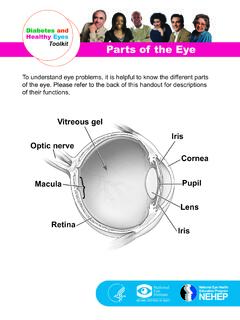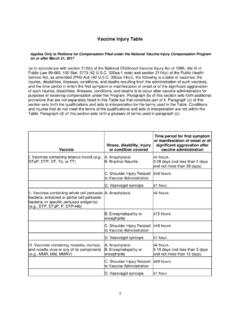Transcription of Diabetic Retinopathy - National Eye Institute
1 DiabeticRetinopathyWhat should knowDiabetic Retinopathy : What you should knowThis booklet is for people with Diabetic Retinopathy and their families and friends. It provides information about Diabetic Retinopathy and answers questions about the cause and symptoms of this progressive eye disease. Diagnosis and types of treatment are National Eye Institute (NEI) conducts and supports research that leads to sight-saving treatments and plays a key role in reducing visual impairment and blindness. The NEI is part of the National Institutes of Health (NIH), an agency of the Department of Health and Human Services.
2 For more information about the NEI, contact: National Eye Institute National Institutes of Health 2020 Vision Place Bethesda, MD 20892 3655 Telephone: 301 496 5248 E-mail: Website: is Diabetic Retinopathy ? ..1 What are the stages of Diabetic Retinopathy ? ..2 Who is at risk for Diabetic Retinopathy ? ..3 How does Diabetic Retinopathy cause vision loss? ..3 Does Diabetic Retinopathy have any symptoms? ..4 What are the symptoms of proliferative Retinopathy if bleeding occurs? ..4 How are macular edema and Diabetic Retinopathy detected? ..5 How is macular edema treated? ..6 How is Diabetic Retinopathy treated?
3 8 What happens during laser treatment? ..9 What is a vitrectomy? ..10 Are scatter laser treatment and vitrectomy effective in treating proliferative Retinopathy ? ..11 What can I do if I already have lost some vision from Diabetic Retinopathy ? ..11 What research is being done? ..11 What can I do to protect my vision? ..12 What should I ask my eye care professional? ..13 Where can I get more information? ..16 What is Diabetic Retinopathy ? Diabetic Retinopathy is a complication of diabetes and a leading cause of blindness. It occurs when diabetes damages the tiny blood vessels inside the retina, the light-sensitive tissue at the back of the eye.
4 (See diagram below.) A healthy retina is necessary for good you have Diabetic Retinopathy , at first you may notice no changes to your vision. But over time, Diabetic Retinopathy can get worse and cause vision loss. Diabetic Retinopathy usually affects both eyes. What are the stages of Diabetic Retinopathy ? Diabetic Retinopathy has four stages:1. Mild Nonproliferative Retinopathy . At this earliest stage, microaneurysms occur. They are small areas of balloon-like swelling in the retina's tiny blood Moderate Nonproliferative Retinopathy . As the disease progresses, some blood vessels that nourish the retina are Severe Nonproliferative Retinopathy .
5 Many more blood vessels are blocked, depriving several areas of the retina with their blood supply. These areas of the retina send signals to the body to grow new blood vessels for Proliferative Retinopathy . At this advanced stage, the signals sent by the retina for nourishment trigger the growth of new blood vessels. This condition is called proliferative Retinopathy . These new blood vessels are abnormal and fragile. They grow along the retina and along the surface of the clear, vitreous gel that fills the inside of the eye. (See diagram on previous page.) By themselves, these blood vessels do not cause symptoms or vision loss.
6 However, they have thin, fragile walls. If they leak blood, severe vision loss and even blindness can result. Who is at risk for Diabetic Retinopathy ?All people with diabetes both type 1 and type 2 are at risk. That's why everyone with diabetes should get a comprehensive dilated eye exam at least once a year. Between 40 to 45 percent of Americans diagnosed with diabetes have some stage of Diabetic Retinopathy . If you have Diabetic Retinopathy , your doctor can recommend treatment to help prevent its pregnancy, Diabetic Retinopathy may be a problem for women with diabetes. To protect vision, every pregnant woman with diabetes should have a comprehensive dilated eye exam as soon as possible.
7 Your doctor may recommend additional exams during your does Diabetic Retinopathy cause vision loss?Blood vessels damaged from Diabetic Retinopathy can cause vision loss in two ways:1. Fragile, abnormal blood vessels can develop and leak blood into the center of the eye, blurring vision. This is proliferative Retinopathy and is the fourth and most advanced stage of the Fluid can leak into the center of the macula, the part of the eye where sharp, straight-ahead vision occurs. The fluid makes the macula swell, blurring vision. This condition is called macular edema. It can occur at any stage of Diabetic Retinopathy , although it is more likely to occur as the disease progresses.
8 About half of the people with proliferative Retinopathy also have macular edema. Does Diabetic Retinopathy have any symptoms? Diabetic Retinopathy often has no early warning signs. Don't wait for symptoms. Be sure to have a comprehensive dilated eye exam at least once a are the symptoms of proliferative Retinopathy if bleeding occurs?At first, you will see a few specks of blood, or spots, floating in your vision. If spots occur, see your eye care professional as soon Normal visionSame scene viewed by a person with Diabetic Retinopathy as possible. You may need treatment before more serious bleeding occurs.
9 Hemorrhages tend to happen more than once, often during , without treatment, the spots clear, and you will see better. However, bleeding can reoccur and cause severely blurred vision. You need to be examined by your eye care professional at the first sign of blurred vision, before more bleeding left untreated, proliferative Retinopathy can cause severe vision loss and even blindness. Also, the earlier you receive treatment, the more likely treatment will be are macular edema and Diabetic Retinopathy detected?Macular edema and Diabetic Retinopathy are detected during a comprehensive eye exam that includes: Visual acuity test.
10 This eye chart test measures how well you see at various distances. Dilated eye exam. Drops are placed in your eyes to widen, or dilate, the pupils. Your eye care professional uses a special magnifying lens to examine your retina and optic nerve for signs of damage and other eye problems. After the exam, your close-up vision may remain blurred for several hours. Tonometry. An instrument measures the pressure inside the eye. Numbing drops may be applied to your eye for this test. Your eye care professional checks your retina for early signs of the disease, including: Leaking blood vessels.









